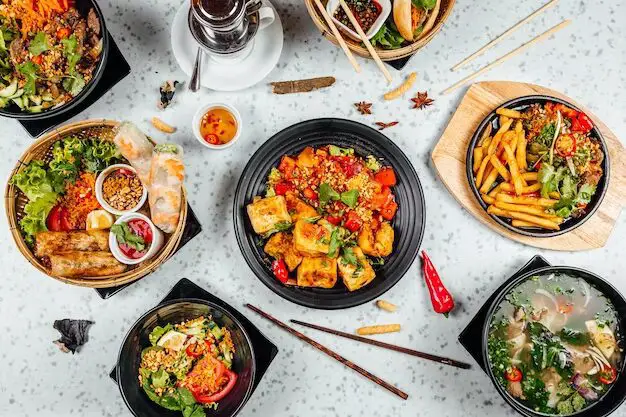Asian Kitchen Menu
Introduction
Welcome to a culinary journey filled with flavors, spices, and the richness of Asian cuisine.
In this article, we will explore the diverse and mouthwatering menu offerings that an Asian kitchen has to offer. Each dish tells a unique story of tradition and culture, from vibrant stir-fries to delectable dumplings. Get ready to tantalize your taste buds as we delve into Asian gastronomy.

Read this: China Kitchen Menu
The Art of Asian Cooking

Understanding the Essence of Asian Kitchen Menu
Asian cuisine is renowned for its harmonious blend of flavors, textures, and colors. With a vast array of ingredients such as aromatic herbs, spices, and fresh produce, Asian dishes are celebrated for their balance and depth of taste. Each region within Asia brings its distinctive style to the table, offering a diverse culinary experience.
Popular Asian Cooking Techniques
Stir-Frying
This technique involves quickly cooking ingredients over high heat while continuously stirring. It preserves the natural flavors and textures of the ingredients, resulting in vibrant and crispy dishes.
Steaming
Steaming is a gentle cooking method that retains the nutrients and flavors of the ingredients. It is commonly used for dumplings, seafood, and vegetables.
Grilling
Grilling imparts a smoky and charred flavor to various Asian dishes. It is often employed for meats, skewers, and barbecue-style dishes.
Read this: Mandarin Kitchen
Exploring the Asian Kitchen Menu

Appetizers
Gyoza
These delightful Japanese dumplings are filled with a savory mixture of ground meat, vegetables, and aromatic seasonings. Served with a dipping sauce, gyoza is a popular choice to kick-start your Asian culinary experience.
Spring Rolls
Crispy and filled with a medley of vegetables, spring rolls offer a delightful crunch with every bite. They are often served with a tangy dipping sauce.
Main Courses
Pad Thai
Originating from Thailand, Pad Thai is a stir-fried noodle dish tossed with tofu, shrimp, or chicken and flavored with tamarind sauce, lime, and peanuts. Its sweet, sour, and savory combination is a crowd-pleaser.
Sushi Rolls
Sushi is a well-known Japanese delicacy that combines vinegar rice, fresh fish or vegetables, and seaweed. From classic options like California rolls to more adventurous choices, sushi is a favorite among food enthusiasts.
Butter Chicken
A classic Indian dish, butter chicken consists of succulent pieces of chicken simmered in a rich tomato and butter-based sauce. The flavors are further enhanced with aromatic spices, making it a true culinary delight.
Side Dishes
Kimchi
Hailing from Korea, kimchi is a traditional fermented cabbage dish that adds a tangy and spicy kick to any meal. Packed with probiotics, it complements the main dishes and aids digestion.
Jasmine Rice
Fragrant and fluffy, jasmine rice is a staple in many Asian cuisines. Its delicate aroma and subtle taste make it the perfect accompaniment to various dishes.
Read this: Dishing out Health
Key Ingredients of the Asian Kitchen Menu

This section will explore some of the key ingredients that make the Asian kitchen menu genuinely remarkable.
Aromatic Herbs and Fresh Produce
Asian cuisine embraces an abundance of aromatic herbs and fresh produce, enhancing each dish’s depth of flavors and nutritional value.
Basil
Thai, holy, and sweet basil are commonly used in Asian cooking. They add a distinct aroma and a refreshing, slightly sweet flavor to various dishes.
Lemongrass
With its citrusy fragrance, lemongrass is a popular herb in Southeast Asian cuisine. It infuses dishes with a unique zing, particularly in soups, curries, and stir-fries.
Cilantro
Cilantro, also known as coriander leaves, is widely utilized in Asian dishes for its bright and refreshing taste. It is often used as a garnish or incorporated into marinades, sauces, and salads.
Fresh Chilies
Chilies are integral to Asian cuisine, providing a fiery kick to dishes. Varieties like Thai bird’s eye chili, Korean gochutgaru, and Indian green chili add spice and heat to recipes.
Unique Spices and Flavor Enhancers
Asian cuisine boasts a rich repertoire of spices and flavor enhancers that elevate dishes to new heights of taste and complexity.
Ginger
Ginger is used in various forms—fresh, dried, or ground—and gives a warm and slightly spicy flavor to Asian dishes. It is known for its digestive properties and is a crucial ingredient in stir-fries, soups, and marinades.
Garlic
Garlic adds a distinct aroma and a robust flavor to Asian recipes. Whether minced, sliced, or crushed, it forms the foundation of many savory dishes, imparting a depth of taste characteristic of Asian cuisine.
Five-Spice Powder
This aromatic blend of spices commonly includes star anise, cloves, cinnamon, Sichuan peppercorns, and fennel seeds. It lends a complex and slightly sweet flavor to Chinese dishes such as roasted meats and stir-fries.
Turmeric
Renowned for its vibrant yellow color, turmeric is a staple spice in Asian cooking. It adds earthy notes and a subtle bitterness while providing potential health benefits due to its anti-inflammatory properties.
Umami-Rich Ingredients
Umami, often called the fifth taste, is a rich, savory flavor that adds depth and complexity to Asian dishes. Several key ingredients contribute to the umami factor.
Soy Sauce
A staple condiment in Asian cuisine, soy sauce adds a savory and salty taste to various dishes. It enhances flavors and serves as a base for marinades, stir-fries, and dipping sauces.
Fish Sauce
Commonly used in Southeast Asian cooking, fish sauce is made from fermented fish and salt. It provides a distinct umami flavor and is critical to Thai, Vietnamese, and Filipino cuisines.
Miso Paste
Originating from Japan, miso paste is made from fermented soybeans. It adds a rich and savory taste to soups, marinades, and glazes, contributing depth and complexity to the overall flavor profile.
Read this: Korean Household Products
The Health Benefits of Asian Kitchen Menu

In this section, we will explore the health advantages derived from embracing the Asian kitchen menu.
An abundance of Nutrient-Rich Ingredients
Asian cuisine features abundant fresh vegetables, herbs, and spices, critical components of a nutritious diet. These ingredients offer a wide range of essential vitamins, minerals, and antioxidants for optimal health.
Vegetables
Leafy Greens
Asian menus often include leafy greens like bok choy, kale, and spinach, which are excellent sources of vitamins A, C, and K, as well as fiber and folate.
Cruciferous Vegetables
Vegetables like broccoli and cabbage are rich in antioxidants, fiber, and phytochemicals that contribute to overall health and may help reduce the risk of chronic diseases.
Herbs and Spices
Turmeric
Widely used in Asian cuisine, turmeric contains a powerful compound called curcumin, known for its anti-inflammatory and antioxidant properties. It may aid in reducing inflammation and promoting overall well-being.
Ginger
Known for its digestive benefits, ginger is commonly used in Asian dishes. It has been shown to alleviate nausea, reduce muscle pain, and possess anti-inflammatory properties.
Lean Proteins and Healthy Fats
Asian cuisine often incorporates lean proteins and healthy fats, contributing to a well-balanced and nutritious diet.
Fish
Omega-3 Fatty Acids
Fish like salmon, mackerel, and sardines are rich in omega-3 fatty acids essential for heart health, brain function, and reducing inflammation.
Lean Protein
Fish is a lean protein source, essential for muscle growth, repair, and overall cellular function.
Tofu and Soy
Plant-Based Protein
Tofu and soy-based products provide a vegetarian or vegan-friendly protein source. They are low in saturated fats and can help promote cardiovascular health.
Isoflavones
Soy products contain isoflavones, linked to potential health benefits such as reducing the risk of certain cancers and improving bone health.
Balanced Flavors and Minimal Processing
Asian cuisine is known for its balanced flavors, achieved through the skillful use of herbs, spices, and natural ingredients. This emphasis on fresh, minimally processed foods contributes to the overall health benefits of the Asian kitchen menu.
Reduced Sodium Intake
Traditional Asian cooking often relies on ingredients’ natural flavors rather than excessive salt. This approach helps lower sodium intake, benefiting cardiovascular health and regulating blood pressure.
Limited Use of Processed Ingredients
The Asian kitchen menu emphasizes whole foods and minimizes using processed ingredients, artificial additives, and preservatives. This focus on natural
Read this: Chuck Norris Health
Conclusion
The Asian kitchen menu opens a gateway to a world of culinary wonders. With its diverse range of dishes, cooking techniques, and health benefits, Asian cuisine continues to captivate food lovers around the globe. From the enticing appetizers to the satisfying main courses and delightful side dishes, each bite tells a story of cultural heritage and gastronomic excellence. So, whether you are a seasoned Asian food enthusiast or a curious newcomer, indulge in the flavors and embark on an unforgettable culinary adventure through the Asian kitchen menu.



